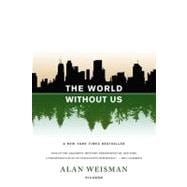
Note: Supplemental materials are not guaranteed with Rental or Used book purchases.
Purchase Benefits
What is included with this book?
Alan Weisman is an award-winning journalist whose reports have appeared in Harper?s, The New York Times Magazine, The Atlantic Monthly, Discover, and on NPR, among others. A former contributing editor to the Los Angeles Times Magazine, he is a senior radio producer for Homelands Productions and teaches international journalism at the University of Arizona. His essay "Earth Without People" (Discover magazine, February 2005), on which The World Without Us expands, was selected for Best American Science Writing 2006.
The New copy of this book will include any supplemental materials advertised. Please check the title of the book to determine if it should include any access cards, study guides, lab manuals, CDs, etc.
The Used, Rental and eBook copies of this book are not guaranteed to include any supplemental materials. Typically, only the book itself is included. This is true even if the title states it includes any access cards, study guides, lab manuals, CDs, etc.
Excerpted from The World Without Us by Alan Weisman
All rights reserved by the original copyright owners. Excerpts are provided for display purposes only and may not be reproduced, reprinted or distributed without the written permission of the publisher.